TALOS dives deeper into brain aneurysm icebergs
The South Korean startup offers ANRISK, an AI-powered solution that detects brain aneurysm risk
By Dec 23, 2024 (Gmt+09:00)
LG Chem to sell water filter business to Glenwood PE for $692 million


KT&G eyes overseas M&A after rejecting activist fund's offer


Mirae Asset to be named Korea Post’s core real estate fund operator


StockX in merger talks with Naver’s online reseller Kream


Meritz backs half of ex-manager’s $210 mn hedge fund


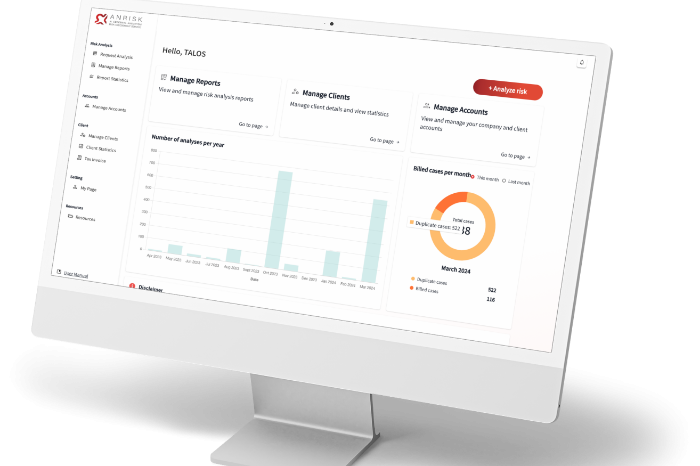
A single neurosurgeon dedicates his or her entire professional career to performing surgeries on an average of fewer than 10,000 patients with brain aneurysms.
But a new brain aneurysm screening tool could prevent hundreds of thousands of such patients from life-threatening conditions, said the chief of South Korean medtech startup TALOS Corp.
In early 2024, TALOS officially launched ANRISK, an artificial intelligence-powered brain aneurysm risk detection solution, which is now used at 30 clinics and hospitals in Korea.
“I thought that developing our service would be a more efficient way to contribute to society,” said Kim Tackeun, founder and chief executive officer of TALOS, in a recent interview with The Korea Economic Daily.
“About 30,000 to 40,000 people experience a brain hemorrhage caused by aneurysm ruptures in Korea every year," said Kim. "This number hasn’t changed much (over time). They are just the tip of the iceberg and we are looking to take care of the colossal underwater iceberg (brain aneurysms at risk of hemorrhage).”
TALOS' CEO is also a neurosurgeon but recently stopped practicing to focus on developing life-saving technologies. He founded TALOS with Joo Jin-deok, who is still a practicing neurosurgeon.
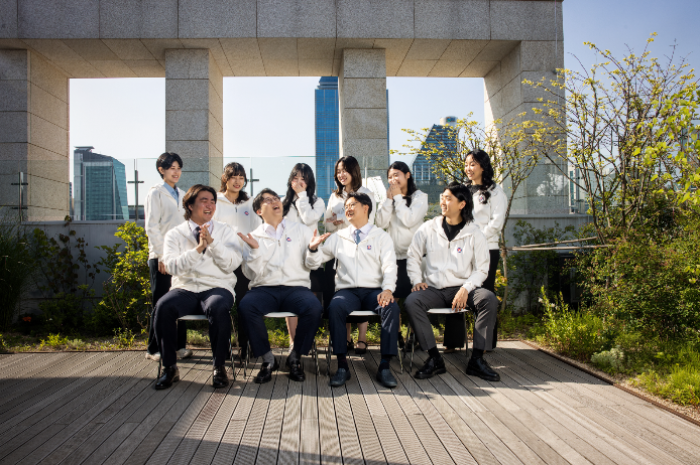
BRAIN ANEURYSM-INDUCED FATAL CONDITIONS ARE PREVENTIVE
A brain aneurysm is a bulge or ballooning of a blood vessel in the brain that forms on a weak area of the vessel wall.
They are usually asymptomatic before they rupture. Upon bursting, however, they cause bleeding in the brain, known as a hemorrhagic stroke (subarachnoid hemorrhage), which is often fatal.
This makes early diagnosis and prevention vitally important, said Kim.
“The cure rate of people with unruptured brain aneurysms stands at over 90% (after treatment). This means that if their brain aneurysms are detected early, most of them can be treated,” said TALOS' CEO.
But such early detection is difficult.
Means for uncovering unruptured brain aneurysms are limited to magnetic resonance angiography (MRA) and computed tomography (CT) scans. But these tests are not for everyone because they cost a lot and pose potential risks to patients due to radiation exposure and the use of contrast agents, making it even more challenging to seize opportunities for early detection.
TALOS developed ANRISK specifically to increase the likelihood of early detection of brain aneurysms, Kim said.
ANRISK POWERED BY AI ALGORITHMS AND DATA SCIENCE
ANRISK is an AI-based platform designed to evaluate the risk of developing a brain aneurysm by analyzing the examinee’s standard health checkup data.
Based on a personalized analysis, it categorizes the risk into five levels: lowest risk, lower risk, average risk, higher risk and highest risk.
The examinees in the two high-risk groups are recommended to receive an imaging test to detect cerebral aneurysms early.
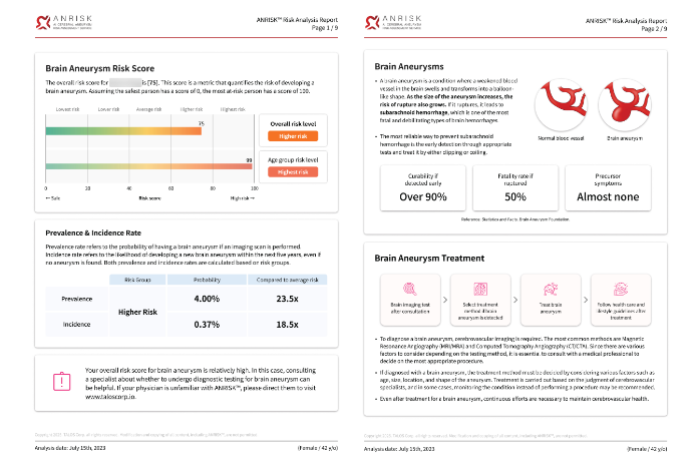
“The brain aneurysm incidence rate of patients in the highest-risk group was about 50 times higher than those in the lowest-risk group,” said Kim. “If those in higher- and highest-risk groups receive imaging tests, about 80% of entire brain aneurysm patients would be discovered.”
According to TALOS’ joint study of patient clinical data in the real world with a local hospital in Korea, 7% of the examinees in ANRISK’s highest-risk group were found to have brain aneurysms when tested with MRAs or CT scans, said TALOS' CEO.
This is very high compared with the 0.8% endoscopic diagnosis rate of gastric cancers, Kim added.
AI TRAINED WITH MASSIVE HEALTH DATA AVAILABLE IN KOREA
ANRISK is trained with a database of a million physical checkups collected and owned by the Korean government from state-backed nationwide general health examinations.
“Korea is one of the very few countries in the world that has accumulated a vast (amount of) health data of their citizens,” said Kim.
Korea’s state-run National Health Insurance Service (NHIS) provides all Korean citizens with free health checkups, including general health and cancer screenings for adults. It offers separate free health screening services for infants and adolescents.
The NHIS manages a separate database for research, and TALOS has used the NHIS-National Health Screening database, which can be accessed only with approval from both the NHIS and the Institutional Review Board.
On top of this, TALOS was able to access the sample cohort’s hospital visit and death records.
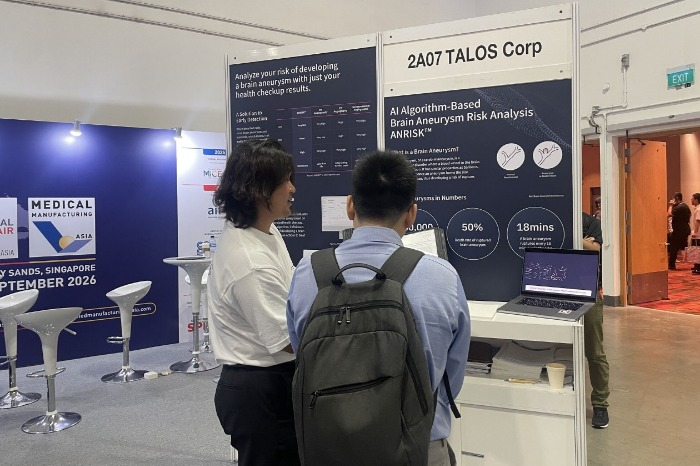
KOREA’S SOLE BRAIN ANEURYSM SCREENING TOOL
Since its official launch in early 2024, ANRISK has been adopted by 30 clinics, hospitals and health check-up organizations in Korea, said Kim, adding that it generates revenue from 15 of them.
There is no fee for ANRISK membership or software and hardware setup.
But TALOS gets paid for the ANRISK analysis of each examinee’s data.
Health examinees can opt for or out of ANRISK analysis during their general health checkups.
TALOS' CEO projects that the company’s revenue will top 100 million won ($70,000) this year.
“Considering the current trend, I expect about 7 to 8 billion won in annual revenue in five years,” said Kim.
BEYOND KOREA
TALOS pins high hopes on ANRISK, which has virtually no direct competitors at home and abroad, said Kim.
“Data size matters the most (in AI). We are proud of our enormous medical data, which is exceptionally bigger than any of our competitors across the world,” said Kim. “I think it would take about 10 years for any clinical development organization to build a similar-level machine learning-backed AI algorithm as ours.”
Because of its accuracy in the early detection of brain aneurysm risk, clients in other countries are keenly interested in ANRISK, said Kim.
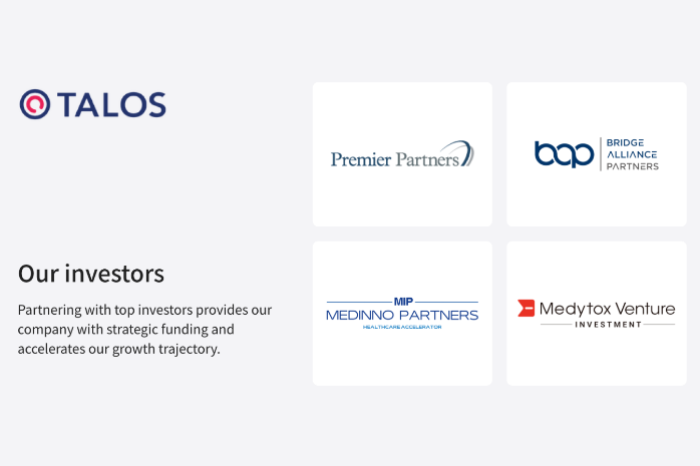
TALOS has been in talks with local companies in Japan to market ANRISK after Japan’s Pharmaceuticals and Medical Devices Agency (PMDA) approved it in October 2023. It received similar approval in Vietnam.
ANRISK is also under review for approval from similar organizations in China, Taiwan, Thailand and India.
“ANRISK is expected to enter these Asian markets soon. Asia is the market we focus on the most now,” said Kim. “We are also seeking to advance into Europe before the US.”
TALOS is seeking to validate ANRISK with a European-heritage cohort via UK Biobank’s database, said TALOS CEO, adding that Germany would be the first country in the region to enter.
REGULATIONS AND FUNDING
To foray into foreign markets, ANRISK must first meet the requirements of the General Data Protection Regulation (GDPR) and obtain approval under the European Union Medical Device Regulation (EU-MDR) in Europe. In the United States, it also must comply with the Health Insurance Portability and Accountability Act (HIPAA) and secure FDA approval.
TALOS has used most of 3.8 billion won raised during its last funding round Series A in December 2023 on compliance and legal issues on top of hiring developers.
It raised a total of 4.3 billion won including seed funding and plans Series A2 or bridge funding in the latter half of next year for global expansion, Kim said.
“We hope to raise funds at a valuation more than three times higher than the current value,” said Kim.
TALOS’ post-money valuation was estimated at 16 billion won after the Series A funding.
“We want to tackle the incidentally found aneurysm with the intentionally found algorithm,” said Kim.
Write to Sookyung Seo at skseo@hankyung.com
Jennifer Nicholson-Breen and Joel Levin edited this article.
-
 Korean startupsEveryone deserves a good night’s sleep: Munice CEO
Korean startupsEveryone deserves a good night’s sleep: Munice CEONov 25, 2024 (Gmt+09:00)
4 Min read -
 Korean startupsBering Lab eyes 7-fold jump in revenue in 5 years
Korean startupsBering Lab eyes 7-fold jump in revenue in 5 yearsNov 21, 2024 (Gmt+09:00)
6 Min read -
 Korean startupsMediaiplus aims to be the Amazon of clinical trials
Korean startupsMediaiplus aims to be the Amazon of clinical trialsNov 01, 2024 (Gmt+09:00)
6 Min read -
 Korean startupsNear Brain gives hope to millions of stroke patients worldwide
Korean startupsNear Brain gives hope to millions of stroke patients worldwideSep 26, 2024 (Gmt+09:00)
6 Min read -
 Korean startupsHudson AI dreams of a world without language barriers
Korean startupsHudson AI dreams of a world without language barriersSep 04, 2024 (Gmt+09:00)
6 Min read -
 Korean startupsYC-backed Relate defies conventional wisdom for deeper integration
Korean startupsYC-backed Relate defies conventional wisdom for deeper integrationAug 27, 2024 (Gmt+09:00)
6 Min read -
 Korean startupsEnormous market ahead for Hopae, S.Korean DID pioneer
Korean startupsEnormous market ahead for Hopae, S.Korean DID pioneerAug 22, 2024 (Gmt+09:00)
5 Min read -
 Korean startupsMLOps startup Vessl AI eyes 50% sales from US in 2025
Korean startupsMLOps startup Vessl AI eyes 50% sales from US in 2025Aug 05, 2024 (Gmt+09:00)
5 Min read -
 Korean startupsColosseum poised for next leap with global expansion drive
Korean startupsColosseum poised for next leap with global expansion driveJul 29, 2024 (Gmt+09:00)
6 Min read -

-
 Korean startupsPhyxUp closes in on pre-seed round with US advance
Korean startupsPhyxUp closes in on pre-seed round with US advanceJul 03, 2024 (Gmt+09:00)
4 Min read -
 Korean startupsDentlink, virtual lab for dentists around the world
Korean startupsDentlink, virtual lab for dentists around the worldJun 20, 2024 (Gmt+09:00)
5 Min read -



